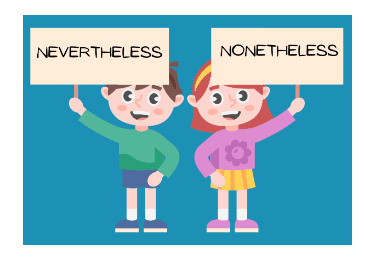Understanding the Transition Words: Nevertheless Vs Nonetheless Explained

Exploring the English language is an exciting journey full of discoveries. One such interesting aspect is transitional phrases like "nevertheless" vs "nonetheless". Often, non-native English speakers find these words confusing. Are they identical? Or do they have distinct meanings?
This blog aims to clarify the difference between "nevertheless" and "nonetheless". We will discuss their definitions, explain their usage, and highlight the differences. We'll thus help you understand these phrases and use them correctly in spoken English.
Defining Nevertheless vs Nonetheless
Transition words help link ideas in sentences, paragraphs, or longer texts. They make writing easier to follow. They improve the flow of the sentences by guiding readers through a logical course of thoughts and arguments. These words show different relationships between ideas. This includes addition, contrast, comparison, cause and effect and sequence.
Let us start by looking at the meaning of "nevertheless" and "nonetheless." Both these transition words are used to indicate contrast or concession. You might often hear them in English conversations or see them in written communications. They have very similar meanings. But they can sometimes be used slightly differently.
Nevertheless is used to introduce a statement that contrasts with or adds to a previous statement. They suggest that despite what has just been said, the following statement is still true or relevant.
Here are some example sentences:
She was tired; nevertheless, she persisted with her studies.
The weather was rainy; nevertheless, they decided to go for a hike.
Nonetheless is similar to nevertheless. It is used to introduce a contrasting or qualifying statement. It emphasizes that the following statement remains true or applicable despite the preceding fact.
Look at the following sentences that use nonetheless:
The restaurant was expensive; nonetheless, the food was excellent.
He failed the first exam. Nonetheless, he managed to pass the course.
Some common synonyms of these words include:
However
Yet
Still
But
Even so
Remember, understanding the meanings and using these words will help improve your English skills. This will make your communication more effective.
Is 'Nevertheless' Interchangeable with 'Nonetheless'?
'Nevertheless' and 'nonetheless' are considered synonyms. They are both adverbs used to suggest contrast or concession in a sentence. There might be slight differences in usage or tone depending on the context. But they are generally interchangeable in most situations.
The word 'nevertheless' suggests a stronger sense of continuing or persisting with an action or argument. For example, "It was raining heavily; nevertheless, he decided to go for a jog". Here 'nevertheless' indicates that despite the rain, the person continued his planned activity.
'Nonetheless' implies a concession or a change in direction. Consider this example: "She didn’t get the job she wanted. Nonetheless, she remains optimistic about her future career prospects". This sentence implies that even though she didn't achieve her immediate goal, it did not cause a change in her attitude towards her career.
To sum up, there's a slight difference in how they're used depending on the context and intended meaning. But most of the time, you can use them interchangeably. So feel free to use these words when speaking English. They can add depth to your conversation and showcase your language skills!
Common Mistakes When Using Nevertheless and Nonetheless

Language learners often struggle with the correct use of 'nevertheless' and 'nonetheless'. It's essential to be aware of the common errors in their usage.
1. Incorrect Positioning: Both words are usually placed at the beginning or in the middle of a sentence to show a contrast.
Incorrect: "I will finish my homework. Nevertheless, I want to play football.".
Correct: "I want to play football. Nevertheless, I will finish my homework."
2. Incorrect Punctuation: 'Nevertheless' and 'nonetheless' should usually be preceded by a full stop (.) or a semicolon (;), and followed by a comma (,) when used at the beginning of a sentence.
Incorrect: "He was tired nevertheless he went for a run.".
Correct: "He was tired. Nevertheless, he went for a run."
3. Redundant Usage: Using these words with conjunctions like 'but' or 'yet' causes repetition.
Incorrect: "It was raining but nevertheless, we decided to go out".
Correct: "It was raining; nevertheless, we decided to go out".
Revisit these rules before using 'nevertheless' and 'nonetheless' in sentences. You can also check out Clapingo's 100 Short Conversational English Tips for Beginners for more guidance on perfecting your conversational English!
How Can Clapingo Help?
In our discussion of 'nevertheless' and 'nonetheless', we've seen how they function as transition words. Why not use these words in your daily discussions?
With Clapingo's personalised coaching, you can master these elements of English language usage. Its native-language instruction approach makes learning natural and effective. This method helps you grasp the usage of similar terms like 'nevertheless' and 'nonetheless'. This will eventually improve your communication skills.
Remember, understanding such phrases is crucial for clear and impactful communication. Mastering these details can enhance your English-speaking abilities. This can make your conversations more clear and accurate.
So why wait? Continue your language learning journey with Clapingo's tailored coaching sessions. Explore Clapingo's courses today and take the next step toward confident English communication!
FAQs
1. How do I use nonetheless?
Nonetheless is used as a linking word to show contrast or contradiction. It's often placed at the beginning of a sentence. For example, "It was pouring rain. Nonetheless, he decided to walk to the store."
2. Where do you use nevertheless in a sentence?
Nevertheless is usually used at the beginning of a sentence or clause. For example, "She was tired after work. Nevertheless, she went to the gym for her workout."
3. What is the difference between nevertheless and despite?
"Nevertheless" and "despite" both indicate contrast, but are used differently. "Despite" is followed by a noun phrase. For instance, "Despite the rain, they continued playing." Nevertheless appears at the beginning of a sentence or clause. For example, "It was raining. Nevertheless, they continued playing."
Comments
Your comment has been submitted successfully!